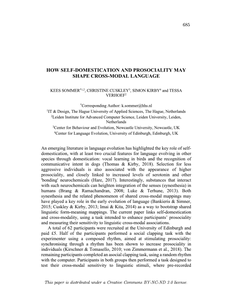This paper links self-domestication and cross-modality, using a task intended to enhance participants’ prosociality and measuring their sensitivity to linguistic cross-modal associations.
DOCUMENT

This chapter will focus on the deep evolutionary history of the cognitive capacities underlying linguistic iconicity. The complex capacity for linguistic iconicity has roots in a more general cross-modal ability present throughout the animal kingdom, cross-modal transfer. Cross-modal transfer is the ability to make basic inferences about sensory properties of an object in multiple modalities based on experience from only one. This situates iconicity as a fundamentally cross-modal phenomenon; part of a broader, uniquely human cross-modal cognitive suite which includes relatively rare phenomena like synesthesia, alongside more ubiquitous phenomena like sensory metaphor and cross-modal correspondences. Evidence suggests the evolutionarily deep capacity for cross-modal transfer was honed into more sophisticated capacities underlying iconicity by an evolutionary ratchet of increased prosociality during human self-domestication. This period provided strong selective pressures for increasingly complex cross-sensory communication, and eventually, the predominantly arbitrary symbolic systems that underpin modern human language. This is a peer-reviewed preprint of the work below.Cuskley, Christine and Kees Sommer (forthcoming). The evolution of linguistic iconicity and the cross-modal cognitive suite. To appear in Olga Fisher, Kimi Akita, and Pamela Perniss (eds.), Oxford Handbook of Iconicity in Language. Oxford University Press: Oxford, UK.
DOCUMENT

ion of verb agreement by hearing learners of a sign language. During a 2-year period, 14 novel learners of Sign Language of the Netherlands (NGT) with a spoken language background performed an elicitation task 15 times. Seven deaf native signers and NGT teachers performed the same task to serve as a benchmark group. The results obtained show that for some learners, the verb agreement system of NGT was difficult to master, despite numerous examples in the input. As compared to the benchmark group, learners tended to omit agreement markers on verbs that could be modified, did not always correctly use established locations associated with discourse referents, and made characteristic errors with respect to properties that are important in the expression of agreement (movement and orientation). The outcomes of the study are of value to practitioners in the field, as they are informative with regard to the nature of the learning process during the first stages of learning a sign language.
DOCUMENT
